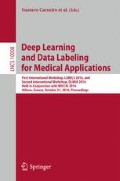Abstract
We propose a novel approach for automatic segmentation of anatomical structures on 3D CT images by voting from a fully convolutional network (FCN), which accomplishes an end-to-end, voxel-wise multiple-class classification to map each voxel in a CT image directly to an anatomical label. The proposed method simplifies the segmentation of the anatomical structures (including multiple organs) in a CT image (generally in 3D) to majority voting for the semantic segmentation of multiple 2D slices drawn from different viewpoints with redundancy. An FCN consisting of “convolution” and “de-convolution” parts is trained and re-used for the 2D semantic image segmentation of different slices of CT scans. All of the procedures are integrated into a simple and compact all-in-one network, which can segment complicated structures on differently sized CT images that cover arbitrary CT scan regions without any adjustment. We applied the proposed method to segment a wide range of anatomical structures that consisted of 19 types of targets in the human torso, including all the major organs. A database consisting of 240 3D CT scans and a humanly annotated ground truth was used for training and testing. The results showed that the target regions for the entire set of CT test scans were segmented with acceptable accuracies (89 % of total voxels were labeled correctly) against the human annotations. The experimental results showed better efficiency, generality, and flexibility of this end-to-end learning approach on CT image segmentations comparing to conventional methods guided by human expertise.
Access this chapter
Tax calculation will be finalised at checkout
Purchases are for personal use only
References
Doi, K.: Computer-aided diagnosis in medical imaging: historical review, current status and future potential. Comput. Med. Imaging Graph. 31, 198–211 (2007)
Lay, N., Birkbeck, N., Zhang, J., Zhou, S.K.: Rapid multi-organ segmentation using context integration and discriminative models. In: Gee, J.C., Joshi, S., Pohl, K.M., Wells, W.M., Zöllei, L. (eds.) IPMI 2013. LNCS, vol. 7917, pp. 450–462. Springer, Heidelberg (2013)
Wolz, R., Chu, C., Misawa, K., Fujiwara, M., Mori, K., Rueckert, D.: Automated abdominal multi-organ segmentation with subject-specific atlas generation. IEEE Trans. Med. Imaging 32(9), 1723–1730 (2013)
Okada, T., Linguraru, M.G., Hori, M., Summers, R.M., Tomiyama, N., Sato, Y.: Abdominal multi-organ segmentation from CT images using conditional shape-location and unsupervised intensity priors. Med. Image Anal. 26(1), 1–18 (2015)
Bagci, U., Udupa, J.K., Mendhiratta, N., Foster, B., Xu, Z., Yao, J., Chen, X., Mollura, D.J.: Joint segmentation of anatomical and functional images: applications in quantification of lesions from PET, PET-CT, MRI-PET, and MRI-PET-CT images. Med. Image Anal. 17(8), 929–945 (2013)
Shin, H.C., Roth, H.R., Gao, M., Lu, L., Xu, Z., Nogues, I., Yao, J., Mollura, D., Summers, R.M.: Deep convolutional neural networks for computer-aided detection: CNN architectures, dataset characteristics and transfer learning. IEEE Tran. Med. Imaging 35(5), 1285–1298 (2016)
Ciompi, F., de Hoop, B., van Riel, S.J., Chung, K., Scholten, E., Oudkerk, M., de Jong, P., Prokop, M., van Ginneken, B.: Automatic classification of pulmonary peri-fissural nodules in computed tomography using an ensemble of 2D views and a convolutional neural network out-of-the-box. Med. Image Anal. 26(1), 195–202 (2015)
de Brebisson, A., Montana, G.: Deep neural networks for anatomical brain segmentation. In: Proceedings of CVPR, Workshops, pp. 20–28 (2015)
Roth, H.R., Farag, A., Lu, L., Turkbey, E.B., Summers, R.M.: Deep convolutional networks for pancreas segmentation in CT imaging. In: Proceedings of SPIE, Medical Imaging 2016: Image Processing, vol. 9413, pp. 94131G-1–94131G-8 (2015)
Cha, K.H., Hadjiiski, L., Samala, R.K., Chan, H.P., Caoili, E.M., Cohan, R.H.: Urinary bladder segmentation in CT urography using deep-learning convolutional neural network and level sets. Med. Phys. 43(4), 1882–1896 (2016)
Long, J., Shelhamer, E., Darrell, T.: Fully convolutional networks for semantic segmentation. In: Proceedings of CVPR, pp. 3431–3440 (2015)
Simonyan, K., Zisserman, A.: Very deep convolutional networks for large-scale image recognition. In: Proceedings of ICLR. arXiv:1409.1556 (2015)
Zhou, X., Ito, T., Takayama, R., Wang, S., Hara, T., Fujita, H.: First trial and evaluation of anatomical structure segmentations in 3D CT images based only on deep learning. In: Medical Image and Information Sciences (2016, in press)
Zhou, X., Morita, S., Zhou, X., Chen, H., Hara, T., Yokoyama, R., Kanematsu, M., Hoshi, H., Fujita, H.: Automatic anatomy partitioning of the torso region on CT images by using multiple organ localizations with a group-wise calibration technique. In: Proceedings of SPIE Medical Imaging 2015: Computer-Aided Diagnosis, vol. 9414, pp. 94143K-1–94143K-6 (2015)
Acknowledgments
The authors would like to thank all the members of the Fujita Laboratory in the Graduate School of Medicine, Gifu University for their collaborations. We would like to thank all the members of the Computational Anatomy [13] research project, especially Dr. Ueno of Tokushima University, for providing the CT image database. This research was supported in part by a Grant-in-Aid for Scientific Research on Innovative Areas (Grant No. 26108005), and in part by a Grant-in-Aid for Scientific Research (C26330134), MEXT, Japan.
Author information
Authors and Affiliations
Corresponding author
Editor information
Editors and Affiliations
Rights and permissions
Copyright information
© 2016 Springer International Publishing AG
About this paper
Cite this paper
Zhou, X., Ito, T., Takayama, R., Wang, S., Hara, T., Fujita, H. (2016). Three-Dimensional CT Image Segmentation by Combining 2D Fully Convolutional Network with 3D Majority Voting. In: Carneiro, G., et al. Deep Learning and Data Labeling for Medical Applications. DLMIA LABELS 2016 2016. Lecture Notes in Computer Science(), vol 10008. Springer, Cham. https://doi.org/10.1007/978-3-319-46976-8_12
Download citation
DOI: https://doi.org/10.1007/978-3-319-46976-8_12
Published:
Publisher Name: Springer, Cham
Print ISBN: 978-3-319-46975-1
Online ISBN: 978-3-319-46976-8
eBook Packages: Computer ScienceComputer Science (R0)

